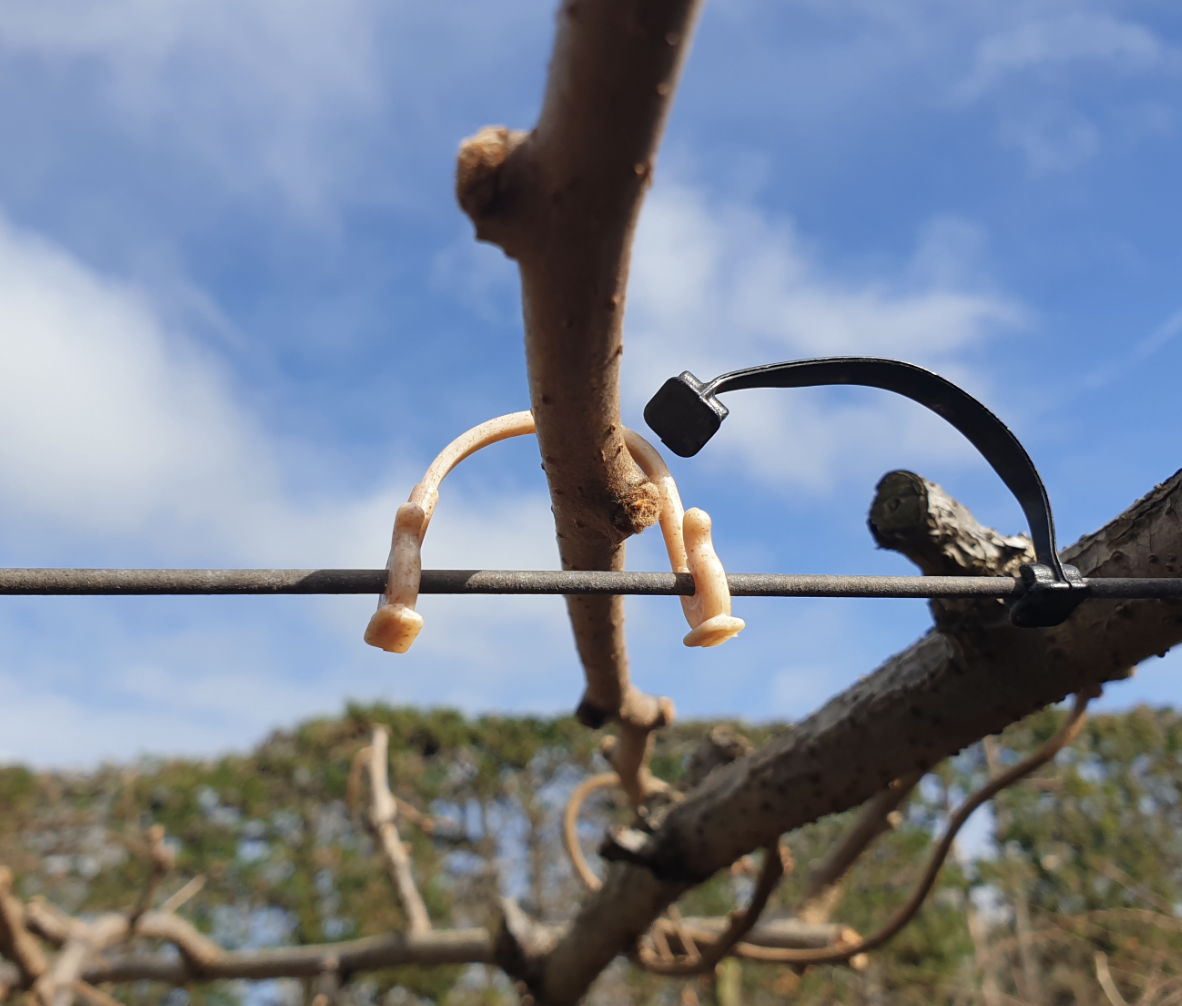The Hidden Cost of Plastic Plant Clips in Agricultural Soil

Picture this: it's harvest time at a commercial greenhouse. Workers cut down thousands of tomato vines, ready to compost them and return nutrients to the soil. But there's a problem lurking in every bundle—hundreds of tiny plastic clips that should support the plants, but now contaminate the very compost meant to nourish the next crop.
It's a cycle playing out in greenhouses across the globe, and it's costing growers far more than they realize.
The scale of plastic contamination in agriculture
The numbers tell a sobering story. Over 95 percent of single-use plastics in horticulture never get recycled. Why? Most agricultural plastics are made from polypropylene (PP), a low-value material that recycling facilities rarely accept. When you add soil residue, plant matter, and organic debris to the mix, these plastics become completely incompatible with existing recycling streams.
Plant support clips are a perfect example of this problem. The global vine clip market reached $1.2 billion in 2024 and is projected to grow to $2.5 billion by 2033. That's a lot of plastic heading into our soil systems—or requiring expensive labor to remove.
For tomato, cucumber, and pepper growers who use trellising systems, these clips are essential. They hold vines securely throughout the growing season. But when harvest arrives, growers face an impossible choice: spend hours manually removing thousands of clips from each crop, or let plastic fragments contaminate their compost and ultimately their soil.
How plastic clips contaminate the growing environment
Here's the reality we need to talk about: conventional plastic clips don't disappear. When vines are cut and composted with clips still attached, those plastic fragments persist. Some break into smaller pieces through mechanical action and UV exposure. Others remain intact for years, even decades.
The contamination happens in stages. First, clips attached to harvested vines enter the compost stream. During composting, they may fragment but never truly degrade. When this contaminated compost gets applied back to fields or growing beds, plastic particles become embedded in the soil matrix. Over time, these accumulate, changing soil structure and introducing foreign materials into what should be a closed-loop nutrient system.
This isn't just an aesthetic problem or a matter of principle. Plastic contamination in soil affects water retention, microbial activity, and root development. The fragments create physical barriers that disrupt natural soil processes, and we're only beginning to understand the long-term ecological implications.
The financial burden on growers
Every greenhouse manager knows the math: labor costs are one of the biggest line items on the balance sheet. When your team spends hours picking plastic clips off vines before composting, that's time not spent on higher-value activities like plant care, pest management, or quality control.
Consider a mid-sized greenhouse operation growing tomatoes on 5 hectares. With standard trellising techniques, you might use 50,000 to 100,000 clips per hectare per season. If workers need to manually remove these at harvest, you're looking at significant labor hours—and remember, this happens multiple times per year for continuous cropping systems.
There's also the disposal dilemma. Clips removed from vines still need to go somewhere. Landfill fees have been climbing steadily, with increases of over 20 percent in some regions since 2024. When you can't recycle contaminated agricultural plastics, every kilogram adds to both your waste bill and your environmental footprint.
Then there's the opportunity cost. Contaminated compost is lower quality compost. If plastic fragments compromise your soil amendments, you may need to source additional inputs or deal with reduced yields over time. These costs are harder to quantify but very real.
Why recycling isn't the answer
You might wonder: can't we just recycle these clips? The unfortunate reality is that agricultural plastics face nearly insurmountable recycling barriers.
The contamination problem is fundamental. Soil, moisture, and plant residue make these plastics undesirable for recyclers. The economics don't work either—the cost of cleaning and processing low-value PP clips exceeds their recovered material value. Collection and transportation add another layer of complexity. Unlike post-consumer plastics with established collection infrastructure, agricultural plastics are dispersed across remote growing operations.
The material composition itself creates challenges. Many clips combine different plastic types or include additives that further complicate recycling. Even when facilities theoretically can process agricultural PP, they often choose not to due to contamination concerns and slim profit margins.
This leaves growers in an impossible position: products designed for single-season use with no viable end-of-life solution.
The bigger picture: systems that need to change
While individual growers can take action today, we also need to acknowledge the systemic gaps that perpetuate the plastic problem in agriculture.
Regulatory frameworks haven't kept pace with the realities of agricultural plastic use. Extended producer responsibility (EPR) schemes that work for consumer packaging often exclude agricultural plastics entirely. There's little incentive for manufacturers to design for end-of-life when disposal becomes someone else's problem.
Infrastructure gaps compound the issue. Even when growers want to do the right thing, collection systems for agricultural plastics are limited or non-existent in many regions. The economics of rural recycling collection make it unlikely this will change without policy intervention.
Certification standards and labeling for compostable products need continued refinement too. Growers need clear, trustworthy information about what "compostable" really means in practical terms. Does it require industrial composting facilities, or will it work in basic field composting? Third-party verification from organizations providing home-compostability certification helps cut through marketing claims and greenwashing.
Progress is happening, though. Rising landfill levies and tightening environmental regulations are creating economic pressure for change. Forward-thinking growers are demonstrating that sustainable alternatives can work at commercial scale. Material science innovations are making truly biodegradable options more accessible and affordable.
Solutions that work in the real world
The good news? Real alternatives exist that eliminate the plastic contamination problem entirely.
Home-compostable plant clips represent a fundamental shift in thinking. Instead of designing clips that need to be removed and disposed of, what if they could break down naturally alongside the plant material they support? This isn't just theory—it's happening now in commercial operations.
Compostify's vine clips, made from certified home-compostable bioplastics, perform exactly like conventional plastic during the growing season. They provide the same structural support, the same UV resistance, and the same ease of use on standard equipment. The difference comes at harvest: when vines are cut for composting, the clips can stay attached. They'll break down completely in compost conditions, leaving no microplastics or toxic residues behind.
This approach delivers immediate labor savings. Greenhouse operators who've made the switch report that eliminating clip removal saves substantial time at harvest—time that can be redirected to revenue-generating activities. There's no sorting, no bagging of plastic waste, and no disposal fees for contaminated materials.
Beyond compostable clips, some growers are exploring alternative trellising methods like biodegradable twine systems, though these often require changes to growing infrastructure. Others are working with plant breeders to develop more structurally robust varieties that need less support, though this is a longer-term solution.
The key is matching the solution to your operation's specific needs. For most commercial greenhouses, compostable clips offer the fastest path to eliminating plastic contamination without disrupting existing workflows.
Growing toward a cleaner future
The path forward isn't just about switching products—it's about rethinking our relationship with the materials we bring into food production systems. Every decision to choose soil-compatible materials over persistent plastics is a vote for agricultural systems that can truly be circular.
For growers, the business case has never been stronger. Compostable clips are now at or near the same price as conventional plastic. When you add in the labor savings from eliminating clip removal, reduced disposal fees, improved compost quality, and better long-term soil health—the old way of doing things simply doesn't make economic sense anymore.
We're not talking about paying a premium for sustainability. We're talking about a solution that saves time, saves money, reduces your carbon footprint, and creates a truly circular system. The choice has become remarkably straightforward.
The transformation is already underway in operations across New Zealand, Australia, and parts of the United States. Commercial greenhouse growers are proving that high-yield, high-quality production is completely compatible with materials that return safely to soil.
Together, we can build an agricultural system where every component—from seed to support clip—is designed with its end of life in mind. Where compost is truly clean and soil health improves with every season. Where growers spend less time managing plastic waste and more time growing exceptional crops.
That future is possible. In fact, it's already growing.

.png)